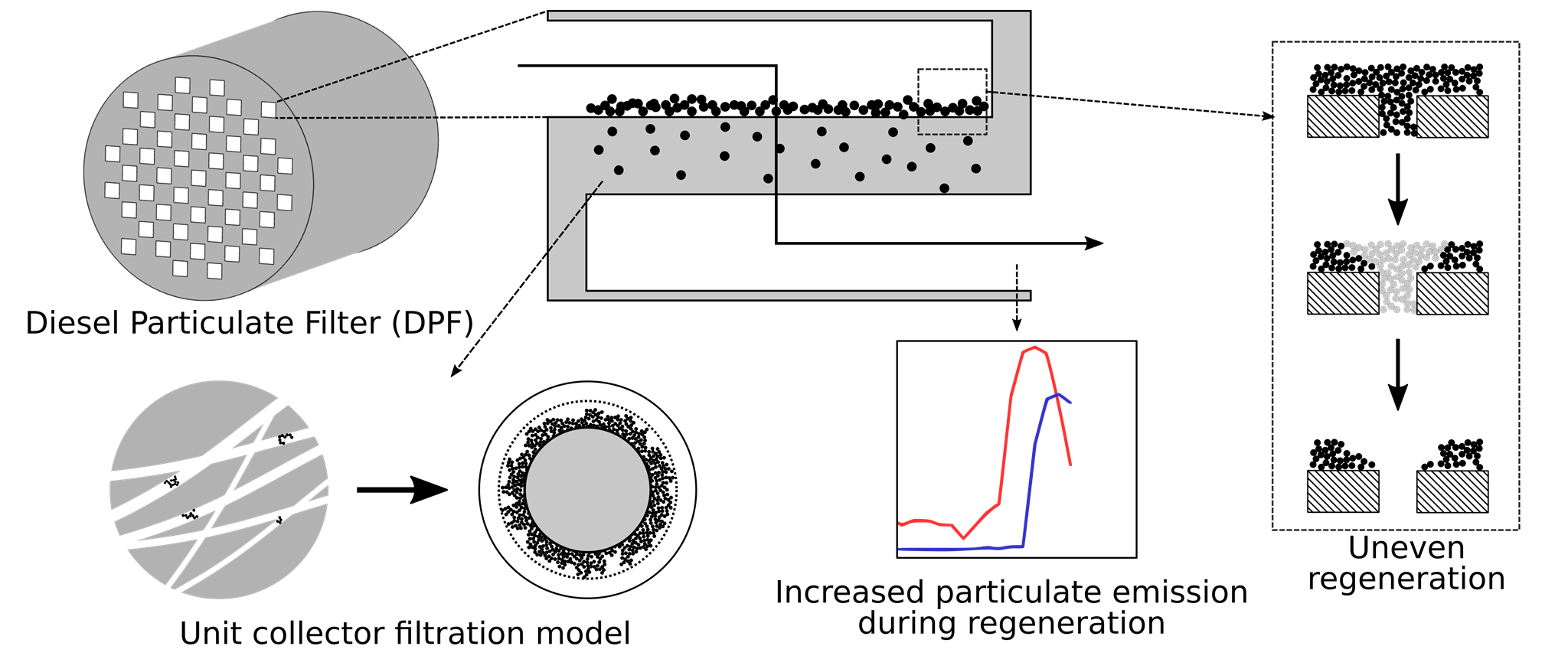Technical Report 208, c4e-Preprint Series, Cambridge
Modelling Particle Mass and Particle Number Emissions during the Active Regeneration of Diesel Particulate Filters
Reference: Technical Report 208, c4e-Preprint Series, Cambridge, 2018
- Modelling study on filtration behaviour of Diesel Particulate Filter (DPF) during active regeneration
- One of the first comparisons between filtration model and experimental data for DPF active regeneration
- Extended state-of-the-art filtration model to improve description of experimental observation
 A new model has been developed to describe the size-dependent effects that are responsible for transient particle mass (PM) and particle number (PN) emissions observed during experiments of the active regeneration of Diesel Particulate Filters (DPFs). The model uses a population balance approach to describe the size of the particles entering and leaving the DPF, and accumulated within it. The population balance is coupled to a unit collector model that describes the filtration of the particles in the porous walls of the DPF and a reactor network model that is used to describe the geometry of the DPF. Two versions of the unit collector model were investigated. The original version, based on current literature, and an extended version, developed in this work, that includes terms to describe both the non-uniform regeneration of the cake and thermal expansion of the pores in the DPF. Simulations using the original unit collector model were able to provide a good description of the pressure drop and PM filtration efficiency during the loading of the DPF, but were unable to adequately describe the change in filtration efficiency during regeneration of the DPF. The introduction of the extended unit collector description enabled the model to describe both the timing of particle breakthrough and the final steady filtration efficiency of the hot regenerated DPF. Further work is required to understand better the transient behaviour of the system. In particular, we stress the importance that future experiments fully characterise the particle size distribution at both the inlet and outlet of the DPF.
A new model has been developed to describe the size-dependent effects that are responsible for transient particle mass (PM) and particle number (PN) emissions observed during experiments of the active regeneration of Diesel Particulate Filters (DPFs). The model uses a population balance approach to describe the size of the particles entering and leaving the DPF, and accumulated within it. The population balance is coupled to a unit collector model that describes the filtration of the particles in the porous walls of the DPF and a reactor network model that is used to describe the geometry of the DPF. Two versions of the unit collector model were investigated. The original version, based on current literature, and an extended version, developed in this work, that includes terms to describe both the non-uniform regeneration of the cake and thermal expansion of the pores in the DPF. Simulations using the original unit collector model were able to provide a good description of the pressure drop and PM filtration efficiency during the loading of the DPF, but were unable to adequately describe the change in filtration efficiency during regeneration of the DPF. The introduction of the extended unit collector description enabled the model to describe both the timing of particle breakthrough and the final steady filtration efficiency of the hot regenerated DPF. Further work is required to understand better the transient behaviour of the system. In particular, we stress the importance that future experiments fully characterise the particle size distribution at both the inlet and outlet of the DPF.
Material from this preprint has been published in Proceedings of the Combustion Institute.
PDF (3.4 MB)



